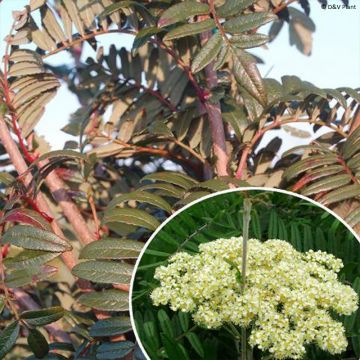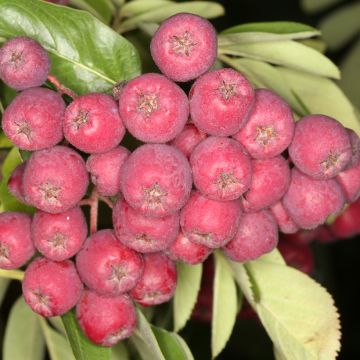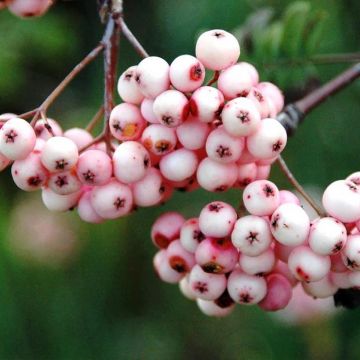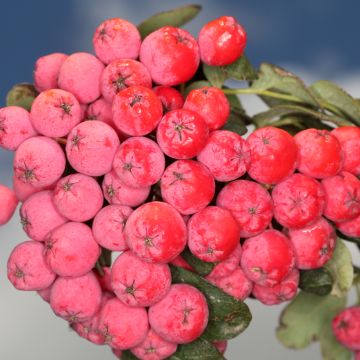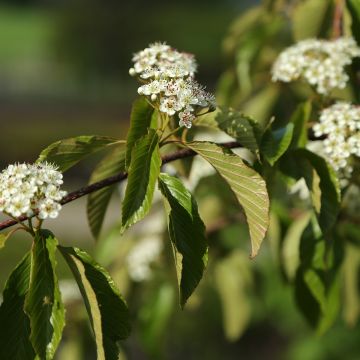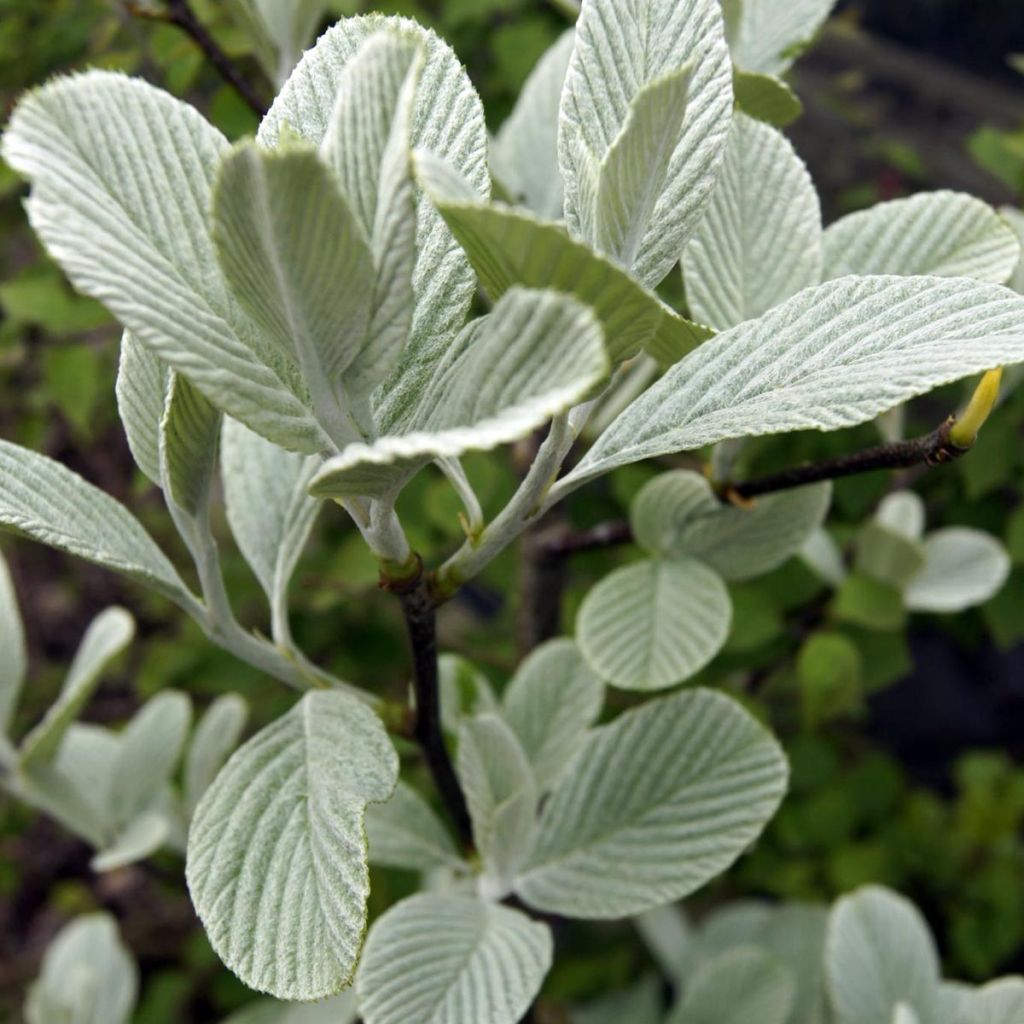

Sorbus wardii
Sorbus wardii
Sorbus wardii
Tibetan Whitebeam
Why not try an alternative variety in stock?
View all →This plant carries a 24 months recovery warranty
More information
We guarantee the quality of our plants for a full growing cycle, and will replace at our expense any plant that fails to recover under normal climatic and planting conditions.
From €5.90 for pickup delivery and €6.90 for home delivery
Express home delivery from €8.90.
Does this plant fit my garden?
Set up your Plantfit profile →
Description
The Sorbus wardii, also known as the Tibetan Mountain Ash, is a new variety that is still relatively uncommon in the market and is highly decorative with its large, round, and very fuzzy foliage that gives it a silver, shiny hue. It forms a small tree or large, rounded bush, reaching a maximum height of 7m, making it perfect for small to medium-sized gardens. Its large elliptical foliage, beautifully marked with deep veins, is entirely covered in a thick layer of white fuzz that illuminates and surprises passersby from spring to autumn. This species blooms in large, creamy-white corymbs from May to June, which are followed by large, bright orange berries in October-November. Hardy down to -20°C (1°F), this tree thrives in full sun and tolerates dry and poor soils, just like its cousin, the Sorbus aria. Plant it in well-drained soils, preferably not too rich, against a hedge or a bed of dark-leaved shrubs to highlight its light foliage.
The Tibetan Mountain Ash belongs to the Rosaceae family. The Sorbus wardii is native to the Himalayas. It is a deciduous small tree or large, rounded bush that typically reaches 7m (23ft) in height and 6m (20ft) in width. The Sorbus wardii has a rounded to oval habit. The deciduous leaves are elliptical to round, with distinct pinnate veins, and are very fuzzy on both sides, giving the tree a silvery and shimmering appearance when the wind blows. The flowering occurs in May-June, in the form of small, creamy-white flowers gathered in terminal corymbs. It is followed by bright orange fruits with a mealy pulp that birds adore. Plant the Tibetan Mountain Ash in well-drained soils, from moist to dry, acidic, neutral to alkaline. It can thrive in both full sun and partial shade, but it prefers full light. This small tree has no specific requirements and tolerates poor soils well. Its deep root system means it is advisable to plant it away from buildings, walkways, and terraces. If necessary, perform regular pruning before the start of the growing season, removing any diseased or dead wood and crossing branches. Occasionally, it may be attacked by aphids, red spider mites, or scale insects. This tree can also be affected by canker, rot, and bacterial fire blight.
The Tibetan Mountain Ash is suitable for informal hedges, woodland gardens, and shade. It can also be planted as a standalone specimen. It is full of charm and can be accommodated in small or large gardens. It can be integrated into a country hedge, accompanied by tall shrubs such as Sea Buckthorn (Hippophae rhamnoides), 'Cornubia' Cotoneaster, Euonymus myrianthus, or Persian Ironwood (Parrotia persica), or planted against a backdrop of dark foliage with red and purple smoke trees and black-leaved elderberries.
The name Sorbus means "to drink" in Latin, alluding to the very astringent fruits of the type species that cause thirst. The wood of the Mountain Ash is very fine and is used in cabinetmaking and woodturning. Aria, Arie, is the name of a province in ancient Persia, situated east of Persia and northwest of India, corresponding to the region of Herat, a province in western Afghanistan. It is also the botanical name of the Mountain Ash. The crossbreeding of the whitebeam with the common pear gave rise to an intergeneric hybrid named x Sorbopyrus auricularis, which bears delicious fruits.
Report an error about the product description
Sorbus wardii in pictures
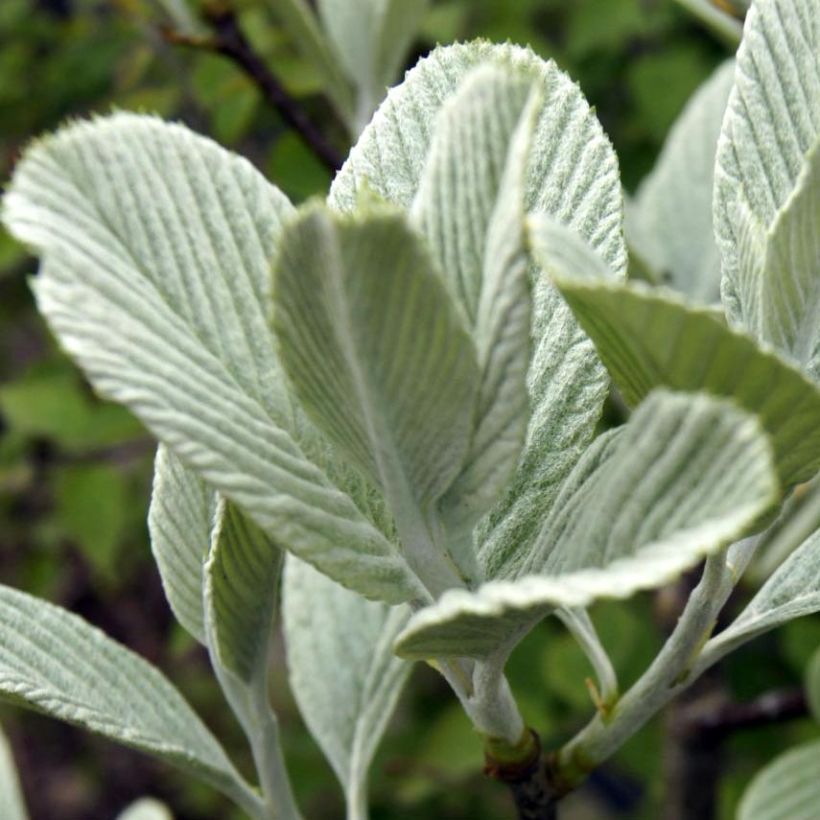

Plant habit
Flowering
Foliage
Botanical data
Sorbus
wardii
Rosaceae
Tibetan Whitebeam
Cultivar or hybrid
Other Sorbus - Mountain Ash
Planting and care
Plant Tibetan Rowan in any well-drained soil, from ordinary to poor, even dry. It will grow in partial shade but prefers very exposed situations, in full sun. This small tree has no specific requirements. As its roots are deep, it is advisable to plant it far from buildings, walkways, and terraces. If necessary, pruning should be carried out before the vegetation resumes, removing diseased or dead wood and crossed branches. Sometimes aphids, red spiders, or scale insects can be observed attacking this tree. It may also be susceptible to canker, root rot, and fire blight.
Planting period
Intended location
Care
This item has not been reviewed yet - be the first to leave a review about it.
Haven't found what you were looking for?
Hardiness is the lowest winter temperature a plant can endure without suffering serious damage or even dying. However, hardiness is affected by location (a sheltered area, such as a patio), protection (winter cover) and soil type (hardiness is improved by well-drained soil).

Photo Sharing Terms & Conditions
In order to encourage gardeners to interact and share their experiences, Promesse de fleurs offers various media enabling content to be uploaded onto its Site - in particular via the ‘Photo sharing’ module.
The User agrees to refrain from:
- Posting any content that is illegal, prejudicial, insulting, racist, inciteful to hatred, revisionist, contrary to public decency, that infringes on privacy or on the privacy rights of third parties, in particular the publicity rights of persons and goods, intellectual property rights, or the right to privacy.
- Submitting content on behalf of a third party;
- Impersonate the identity of a third party and/or publish any personal information about a third party;
In general, the User undertakes to refrain from any unethical behaviour.
All Content (in particular text, comments, files, images, photos, videos, creative works, etc.), which may be subject to property or intellectual property rights, image or other private rights, shall remain the property of the User, subject to the limited rights granted by the terms of the licence granted by Promesse de fleurs as stated below. Users are at liberty to publish or not to publish such Content on the Site, notably via the ‘Photo Sharing’ facility, and accept that this Content shall be made public and freely accessible, notably on the Internet.
Users further acknowledge, undertake to have ,and guarantee that they hold all necessary rights and permissions to publish such material on the Site, in particular with regard to the legislation in force pertaining to any privacy, property, intellectual property, image, or contractual rights, or rights of any other nature. By publishing such Content on the Site, Users acknowledge accepting full liability as publishers of the Content within the meaning of the law, and grant Promesse de fleurs, free of charge, an inclusive, worldwide licence for the said Content for the entire duration of its publication, including all reproduction, representation, up/downloading, displaying, performing, transmission, and storage rights.
Users also grant permission for their name to be linked to the Content and accept that this link may not always be made available.
By engaging in posting material, Users consent to their Content becoming automatically accessible on the Internet, in particular on other sites and/or blogs and/or web pages of the Promesse de fleurs site, including in particular social pages and the Promesse de fleurs catalogue.
Users may secure the removal of entrusted content free of charge by issuing a simple request via our contact form.
The flowering period indicated on our website applies to countries and regions located in USDA zone 8 (France, the United Kingdom, Ireland, the Netherlands, etc.)
It will vary according to where you live:
- In zones 9 to 10 (Italy, Spain, Greece, etc.), flowering will occur about 2 to 4 weeks earlier.
- In zones 6 to 7 (Germany, Poland, Slovenia, and lower mountainous regions), flowering will be delayed by 2 to 3 weeks.
- In zone 5 (Central Europe, Scandinavia), blooming will be delayed by 3 to 5 weeks.
In temperate climates, pruning of spring-flowering shrubs (forsythia, spireas, etc.) should be done just after flowering.
Pruning of summer-flowering shrubs (Indian Lilac, Perovskia, etc.) can be done in winter or spring.
In cold regions as well as with frost-sensitive plants, avoid pruning too early when severe frosts may still occur.
The planting period indicated on our website applies to countries and regions located in USDA zone 8 (France, United Kingdom, Ireland, Netherlands).
It will vary according to where you live:
- In Mediterranean zones (Marseille, Madrid, Milan, etc.), autumn and winter are the best planting periods.
- In continental zones (Strasbourg, Munich, Vienna, etc.), delay planting by 2 to 3 weeks in spring and bring it forward by 2 to 4 weeks in autumn.
- In mountainous regions (the Alps, Pyrenees, Carpathians, etc.), it is best to plant in late spring (May-June) or late summer (August-September).
The harvesting period indicated on our website applies to countries and regions in USDA zone 8 (France, England, Ireland, the Netherlands).
In colder areas (Scandinavia, Poland, Austria...) fruit and vegetable harvests are likely to be delayed by 3-4 weeks.
In warmer areas (Italy, Spain, Greece, etc.), harvesting will probably take place earlier, depending on weather conditions.
The sowing periods indicated on our website apply to countries and regions within USDA Zone 8 (France, UK, Ireland, Netherlands).
In colder areas (Scandinavia, Poland, Austria...), delay any outdoor sowing by 3-4 weeks, or sow under glass.
In warmer climes (Italy, Spain, Greece, etc.), bring outdoor sowing forward by a few weeks.






































